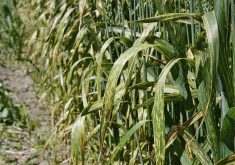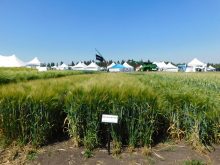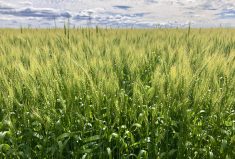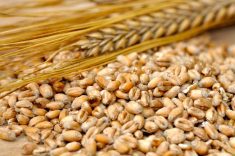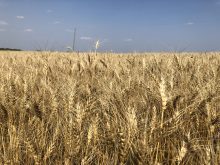It’s a slow process to get international maltsters to accept new barley varieties, partly because of unfamiliarity and partly because farmers aren’t growing enough of them.
“They do prefer what they know, which are varieties like AC Metcalfe and CDC Copeland,” said Peter Watts, managing director of the Canadian Malting Barley Technical Centre.
“But a lot of them have now accepted AAC Synergy. The newer varieties are on their radar, but they haven’t necessarily embraced them.”
His organization is recommending CDC Bow, CDC Fraser and AAC Connect to growers this year.
Read Also

Hail research hopes to benefit potato growers
Alberta research scientist measures hail storm and heat dome affects on potato crops
But Watts acknowledged getting new varieties accepted can be a bit of a chicken-and-egg scenario — growers want to know there’s a strong market for a new variety before growing it while the marketplace wants to know there’ll be enough volume.
“If they were available in 25,000-tonne boatloads, China would buy them,” he said. “The challenge that we still face in Canada from a logistics standpoint is that if you’re a grain company, you only have so many bins, and it’s hard to accommodate five or six malting varieties.
“The grain companies — and I sympathize with them — they’re caught between a rock and a hard place a little bit. They want to contract malting barley to supply the export market. They would love to contract a new variety but customers are still asking for the old variety.”
But progress is being made.
“We did see a commercial export of CDC Bow to China — the first one ever. That’s great news,” said Watts.
CDC Connect is the most accepted by Chinese buyers, followed by CDC Bow and CDC Fraser.
“So we’re getting there. There is a little bit of reluctance to accept the new varieties until they really know them,” he said. “It’s a little bit of logistics, and now we throw in this whole thing where barley prices are very strong, because of the strong demand for feed from China, which is going to continue.”
China has been on a barley buying spree since slapping steep tariffs on barley from Australia, which angered Beijing by pushing for a UN probe into the origins of the coronavirus pandemic.
“In terms of buyers, prices are so high that this might actually help us with getting these new varieties into markets like China next year, where they might be like, ‘Hey, we need malting barley, we’ll take whatever you have,’” said Watts.
Making the pitch
But the Canadian Malting Barley Technical Centre is also reaching out to international customers through a new website, barleyharvest.ca. Launched last fall, the website provides information on varieties, crop quality and technical specs (in five languages) as well as photos and short videos from Prairie farms.
The website is also aimed at producers and encourages them to consider growing new varieties.
“AAC Synergy is the best yielder, but Bow, Connect and Fraser are really good yielders,” said Watts. “What we’re trying to get across to producers this year (is) if you’re going to grow malting barley, consider these malting varieties that have really good agronomics, disease packages, and great malting quality.
“If you get malt, that’s great. But if you don’t, you can sell it as feed and you don’t lose that much in terms of yield.”
Growing a malting barley variety gives growers access to an additional 2.5-million-tonne marketplace, he added.
“If you grow feed barley, you’re only selling to one market. It’s a big market, but there’s another big market there in terms of malting barley. We’re trying to convey this message all the time to producers to convince them to grow these new varieties.”
And while international buyers “wish they could have AC Metcalfe forever,” Canada’s malt barley sector needs better varieties to remain competitive in the long run.
“We need varieties that yield well,” said Watts. “If Metcalfe is topping out for somebody at 75 bushels to the acre, but they can get 100 with Synergy, it’s a no-brainer, and it’s got a better disease package. Now you have these varieties like Connect, Bow and Fraser that are pretty darn close and have better lodging resistance, an even better disease package, and arguably better quality in some areas.”
The domestic market
Canadian maltsters also play an important role in convincing international buyers to accept new varieties.
“Our international customers always ask what the Canadian domestic malting companies are doing,” said Watts. “We work together. We even have a variety acceptance committee that we established last year, and it includes the malting companies and some brewers and we talk about the varieties.
“They are increasingly using and accepting varieties like Connect, Bow and Fraser. Each year, they’ve been increasing their contracting for these varieties. The train is gaining steam, but it’s a slow process.”
And because prices and demand are expected to remain strong for another year, there’s an opening for new varieties.
“Supplies are tight in Canada for barley, the carry-out is low and it will be again next year,” said Watts. “We’re in for another good year of prices. I’m sure we will see a bigger barley area this year. I do think we will see a lot of commercial export of these new varieties.”
That should increase uptake by domestic customers, too.
“Some malting companies are quicker to adopt these new varieties for different reasons,” he said. “It’s a general shift in the industry (but) it does take a little while for everybody to wrap their heads around it.”




